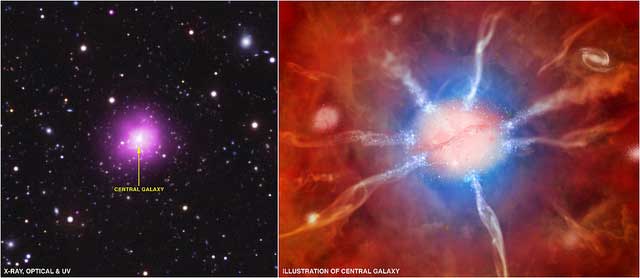Massive galaxy cluster spawns more than 700 stars a year
A newly discovered cluster of galaxies, more than 5 billion light years from Earth…is among the most massive clusters of galaxies in the universe, and produces X-rays at a rate faster than any other known cluster.
It also creates new stars at an “unmatched” pace of more than 700 per year, said Michael McDonald. “This extreme rate of star formation was unexpected,” he said during a NASA news conference Wednesday, noting that the Milky Way forms just one or two stars a year.
In addition to being massive, unique, and the biggest star-nursery in the universe, this area, called Phoenix, also helps theorists with something, the galactic cooling problem.

For years scientists have been coming up with explanations for how stars are formed. The earliest being a mass of molecules would collapse in on themselves as fusion begins. The mass would then accumulate until its gravity becomes strong enough to spin, turn into a sphere, and pull on everything around it, collecting planets, asteroids, and other debris into its solar system.
But, this doesn’t take into account thermodynamics, specifically why doesn’t the star expand as it heats up. Indeed, several half-stars were observed in the universe stuck in this state of expansion unable to contract into the ultra-compact ball of a star.
That’s where a new theory comes in, the galactic “cooling flow”.
**There appears to be no name for the theory, all references are to a general theory theory of star formation.
This says the creation of stars is a lot like an explosion, with an initial burst of heat which then dissipates bringing cool air back into the explosion zone. In this case, thermonuclear fusion ignites much of the galaxy and begins sucking into the center lots of mass, including the surrounding galaxies.
As the (star) forms, this plasma initially heats up due to the gravitational energy released from the infall of smaller galaxies.
As the gas cools, it should condense and sink inward, a process known as a “cooling flow.” In the cluster’s center, this cooling flow can lead to very dense cores of gas, termed “cool cores,” which should fuel bursts of star formation in all clusters that go through this process. Most of these predictions had been confirmed with observations – the X-ray glow, the lower temperatures at the cluster centers – but starbursts accompanying this cooling remain rare. – TG Daily
A step forward in our knowledge of star formation, but something tells me we are not there yet.
Sources:
- Wikipedia: Star, Thermodynamics, & Stellar Evolution.
- NASA Science – Stars
- TG Daily – Astronomers vindicated by frenetic Phoenix Cluster star formation
- Harvard – Star Formation and the Cooling of Molecular Clouds
- NASA Chandra – The remarkable Phoenix Cluster
- Chandra Phoenix Cluster – Press Release